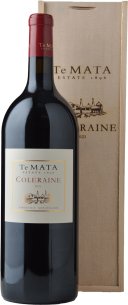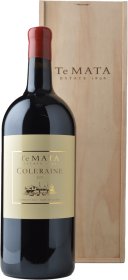Château Ducru-Beaucaillou St-Julien
Reputed to be the leading star of the ''Super Seconds'' of Bordeuax, Chateau Ducru-Beaucaillou is set over 50 hectares of vineyards in the south of St-Julien. The wine is composed from predominately Cabernet Sauvignon and Merlot, with lesser influence from Cabernet Franc and Petit Verdot and spends around 18 months in half new and half seasoned oak barriques. The 2010 vintage has conspired to produce what could arguably called one of the greatest releases of this wine, resplendent with fine, firm tannin, subtle oak, quiet power and a capacity to cellar for another half century.
Te Mata Estate Coleraine Cabernet Sauvignon Merlot Cabernet Franc
TE MATA ESTATE Coleraine. Cepage may include Cabernet Sauvignon, Merlot, and Cabernet Franc. Hawkes Bay, New Zealand
Château Figeac St Emilion
The Premier Grand Cru Classe Château Figeac has a high percentage of mature cabernet sauvignon and cabernet franc vines (40+ years). This gives its wines blackcurrant aromas, robust structure and length. Made by experienced winemaker Frederic Faye, with Michel Rolland, the most famous consultant oenologist in the world, this vintage has the hallmarks of a buoyant Right Bank style.
Château les Carmes-Haut-Brion
Chateau Haut Bailly Pessac
Chateau d'Yquem
The harvest began very early, on the 5th September, and lasted 9 weeks. This made is possible to reflect all the diversity of a year in which both flowering and veraison were very spread out. Picking began especially early at Yquem in 2014. Some 25% of the crop was brought in before the 15th of September, providing a rare and precious background of acidity.
Château Montrose
France's Bordeaux, is the spiritual home of the Cabernet family of grapes, which extends beyond Sauvignon and Franc to Merlot, Malbec and Petit Verdot. If you love Margaret River Cabernet blends, or indeed the Merlot dominant reds of Hawkes Bay, NZ, then you must look at the wines upon which many of them have been modelled. This wine is Cabernet and Merlot, deep and rich, cassis and earthy cedar, structure and uncommon length - all hallmarks of Grand Cru Bordeaux.
Château Palmer
Laurent Ponsot Corton Charlemagne Cuvée du Kalimeris Grand Cru
Laurent Ponsots new company is a stage in a wide-ranging project that began four decades ago. In this different format, Laurent Ponsot continues to use his experience, his craftsmanship and his passion to serve the terroir of Burgundy. The company Laurent Ponsot is neither a domain nor a maison: its a state of mind. To create an exceptional wine is the equivalent of designing luxury goods. Haute couture is how we have decided to describe these incredible wines, like unique designer pieces, made even more glorious through our experience and craftsmanship. In 775 Emperor Charlemagne donated this vineyard to a Catholic institution in Saulieu, which kept it for the next 1000 years! Laurent Ponsot SAS sources its grapes from these three villages via six different producers, making a wine representative of the appellation whose richness is derived from its diversity. The wines are finely chiselled, precise, and rich with the scent of flowers and minerals. Match with fish, shellfish or a cheese platter to perfectly showcase their qualities.
Chateau Vieux Certan
The Vieux Château Certan estate has existed since the mid-1700s, though the date of establishment is unknown. Like all of the wines in the Pomerol Appellation, Vieux Château Certan is not classified but is widely regarded as one of the great growths of the region and one of the worlds great wines.





















